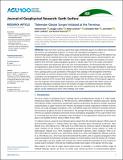Files in this item
Tidewater glacier surges initiated at the terminus
Item metadata
| dc.contributor.author | Sevestre, Heïdi | |
| dc.contributor.author | Benn, Douglas I. | |
| dc.contributor.author | Luckman, Adrian | |
| dc.contributor.author | Nuth, Christopher | |
| dc.contributor.author | Kohler, Jack | |
| dc.contributor.author | Lindbäck, Katrin | |
| dc.contributor.author | Pettersson, Rickard | |
| dc.date.accessioned | 2018-10-25T23:48:36Z | |
| dc.date.available | 2018-10-25T23:48:36Z | |
| dc.date.issued | 2018-04-26 | |
| dc.identifier | 252944993 | |
| dc.identifier | 4eb24f26-fac0-4d77-b48a-f73c25088566 | |
| dc.identifier | 85047633786 | |
| dc.identifier | 000435277100011 | |
| dc.identifier.citation | Sevestre , H , Benn , D I , Luckman , A , Nuth , C , Kohler , J , Lindbäck , K & Pettersson , R 2018 , ' Tidewater glacier surges initiated at the terminus ' , Journal of Geophysical Research - Earth Surface , vol. In press . https://doi.org/10.1029/2017JF004358 | en |
| dc.identifier.issn | 2169-9003 | |
| dc.identifier.other | crossref: 10.1029/2017JF004358 | |
| dc.identifier.other | ORCID: /0000-0002-3604-0886/work/64697389 | |
| dc.identifier.uri | https://hdl.handle.net/10023/16328 | |
| dc.description | TerraSAR-X data were provided by DLR (project OCE1503), and funded by the Conoco Phillips-Lundin Northern Area Program through the CRIOS project (Calving Rates and Impact on Sea level). C.N. acknowledges funding from European Union/ERC (grant 320816) and ESA (project Glaciers CCI, 4000109873/14/I-NB). | en |
| dc.description.abstract | There have been numerous reports that surges of tidewater glaciers in Svalbard were initiated at the terminus and propagated up‐glacier, in contrast with downglacier‐propagating surges of land‐terminating glaciers. Most of these surges were poorly documented, and the cause of this behavior was unknown. We present detailed data on the recent surges of two tidewater glaciers, Aavatsmarkbreen and Wahlenbergbreen in Svalbard. High‐resolution time‐series of glacier velocities and evolution of crevasse patterns show that both surges propagated up‐glacier in abrupt steps. Prior to the surges, both glaciers underwent retreat and steepening, and in the case of Aavatsmarkbreen, we demonstrate that this was accompanied by a large increase in driving stress in the terminal zone. The surges developed in response to two distinct processes. 1) During the late quiescent phase, internal thermodynamic processes and/or retreat from a pinning point caused acceleration of the glacier front, leading to the development of terminal crevasse fields. 2) Crevasses allowed surface melt‐ and rain‐water to access the bed, causing flow acceleration and development of new crevasses up‐glacier. Upward migration of the surge coincided with stepwise expansion of the crevasse field. Geometric changes near the terminus of these glaciers appear to have led to greater strain heating, water production and storage at the glacier bed. Water routing via crevasses likely plays an important role in the evolution of surges. The distinction between internally triggered surges and externally triggered speed‐ups may not be straightforward. The behavior of these glaciers can be understood in terms of the enthalpy cycle model. | |
| dc.format.extent | 2783871 | |
| dc.language.iso | eng | |
| dc.relation.ispartof | Journal of Geophysical Research - Earth Surface | en |
| dc.subject | Glaciers | en |
| dc.subject | Surges | en |
| dc.subject | Tidewater | en |
| dc.subject | Svalbard | en |
| dc.subject | Remote sensing | en |
| dc.subject | Dynamics | en |
| dc.subject | QE Geology | en |
| dc.subject | GE Environmental Sciences | en |
| dc.subject | DAS | en |
| dc.subject.lcc | QE | en |
| dc.subject.lcc | GE | en |
| dc.title | Tidewater glacier surges initiated at the terminus | en |
| dc.type | Journal article | en |
| dc.contributor.institution | University of St Andrews. School of Geography & Sustainable Development | en |
| dc.contributor.institution | University of St Andrews. Bell-Edwards Geographic Data Institute | en |
| dc.identifier.doi | https://doi.org/10.1029/2017JF004358 | |
| dc.description.status | Peer reviewed | en |
| dc.date.embargoedUntil | 2018-10-26 |
This item appears in the following Collection(s)
Items in the St Andrews Research Repository are protected by copyright, with all rights reserved, unless otherwise indicated.

